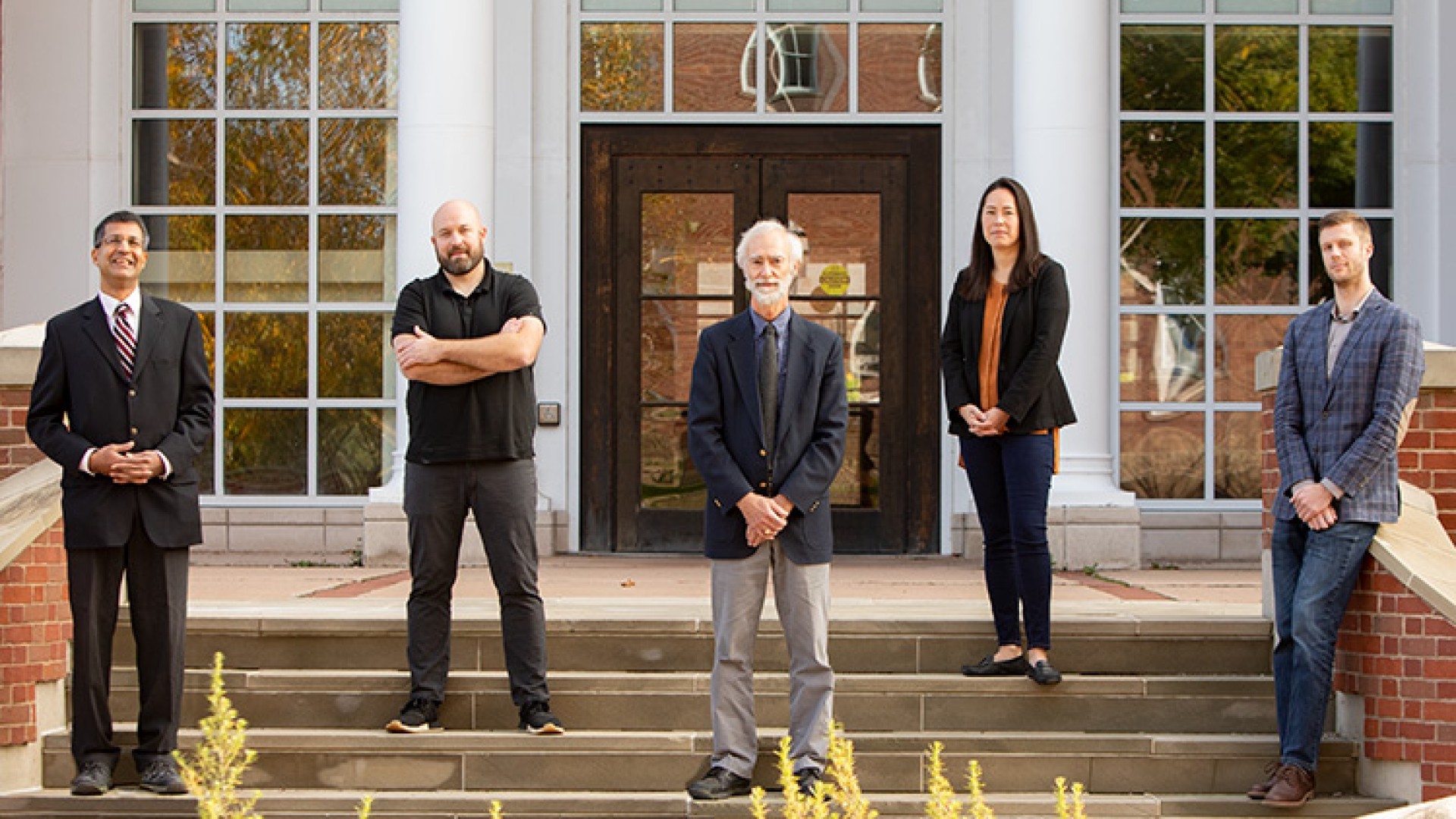
StFX English professor Dr. Earla Wilputte readily admits she was not an experienced online teacher before the COVID-19 pandemic. “I loved teaching in-person and getting to know the students, saying “hi” when I saw them on campus. I was terrified of the technology, the loss of interaction and exchange, and not seeing my students,” says Dr. Wilputte, a past recipient of the StFX Outstanding Teaching Award, who logged countless hours over the spring and summer preparing for online teaching.
She attended at least 17 hours of workshops offered by StFX’s Remote Teaching and Learning Preparedness Task Force—a 26-member body struck this spring to help prepare faculty to teach online—and she paired with an experienced StFX faculty mentor over the summer. Offering a course online is as much work for both Dr. Wilputte and her students, but they’re enjoying it, she says, and a month into the academic term, it’s going well.
Robert Madden, who teaches second and third year accounting in the Schwartz School of Business, likewise invested over four months into learning how to teach online. That investment is paying dividends, he says, as he went from being scared of the technology to quite comfortable with it. “Everyone is trying to do their best, and everyone is trying to do their best for the students,” he says. “That’s why we became so committed.”
For veteran online teacher, education professor Dr. Chris Gilham, another previous StFX Outstanding Teaching Award winner, and mentor for instructors moving to online teaching, every PD session StFX offered had something to teach him—even though he’s been teaching online for seven years. “I was so thankful for them and hope to continue in some regular, structured way. There is so much to learn from one another.”
Strong team effort
As almost 30 per cent of StFX courses successfully moved to remote delivery this fall, StFX faculty stepped forward to meet the challenge, making a monumental effort to welcome students online and to provide students with the best possible learning experience during this unprecedented time.
“People have invested a lot of time into their teaching,” says education professor Dr. Joanne Tompkins, who with Dr. Janice Landry, Director, Continuing and Distance Education, co-chair the Online Task Force.
When the task force started in April, no one knew if StFX would be able to offer face-to-face classes in the fall, Dr. Tompkins says.
Task force members, representing a broad range of university staff, had a huge mission, working hard in a short time period to build capacity. Dr. Tompkins says the task force had terrific uptake. “People were really generous with their spirit. They wanted to make this work.”
She says a definite highlight was the quality of learning and sharing of ideas amongst colleagues.
The transition to delivering courses online went reasonably smoothly, largely due to the extensive preparation and planning of faculty and teaching staff, as well as staff in Continuing and Distance Education and IT Services, say Dr. Landry and Dr. Tompkins.
Instructors attended sessions offered by the Online Task Force, the Teaching and Learning Centre, and the Faculty Development Committee, and worked countless hours preparing course material for this new delivery method.
As well, Continuing and Distance Education and IT Services staff supported instructors, including individually setting up each Collaborate classroom with optimal settings, responding to countless questions; and attending all online courses during the first couple of sessions to troubleshoot.
“I was much impressed by the effort put in by faculty and teaching staff to increase and share their knowledge of online teaching and learning best practices. The turnout at PD sessions illustrated the degree of personal responsibility taken by instructors to make the transition to online delivery as smooth as possible for all participants,” says Shafik Nanji, Senior Instructional Designer with Continuing and Distance Education.
“The quality of questions received by Continuing and Distance Education and IT Services during and following the PD sessions showed just how engaged instructors were in ensuring that their courses went smoothly and that students had the best possible experience of learning online. The receptiveness of faculty and teaching staff to new ideas, grounded in evidence-based concepts from the literature on online teaching and learning best practices, made it a pleasure for me and my colleagues to support the transition of selected courses to an online mode of delivery.”
Learning, moving forward
Dr. Wilputte says the PD sessions set up over the summer offered a great, and gentle way of introducing her, and others, to this new way of teaching.
“I’ve learned that nothing is a catastrophe,” she says. “Last week, I divided my students up into break-out rooms to discuss a poem among themselves. They loved it. They got to meet some of their classmates and exchange ideas. Unfortunately, they couldn’t figure out how to leave their break-out rooms and return to the main classroom, so I began receiving many chat messages saying, “We can’t get out!” “Help us. We’re locked in the room!” It was sad AND hilarious, but I got them all back and we laughed about it. They let me know when I’ve forgotten to turn my mic back on. They send funny chat messages when I can’t figure out which button to push to do a poll or return to a slide. I hope that they’re learning that we all make mistakes—and it’s not the end of the world. We learn and move forward.”
She says online classses are shorter than in-person ones, usually because of technical/connection difficulties, and because it takes longer to communicate through microphones, whiteboards and chat boxes, so students must be prepared beforehand or they can’t cover the material. “They’ve easily adapted to this format—where they take more responsibility for their own learning—probably because it’s just one more new way of taking their classes. It’s great!
“Students seem more open to talking before and after class online. As with my in-person classes, I arrive early and stay afterward to be available to students. Online, they arrive early to chat with me, so there’s a feeling of familiarity and connection. I like it. Online teaching isn’t as alienating and lonely as I thought it might be.”
Flexibility, learning
Philosophy professor Dr. Steve Baldner wanted to be able to teach courses simultaneously in-person and online, and he worked hard to learn how. The learning curve was steep, he says, but it’s been good for the grey matter.
“In-person teaching is important because it is better than online and we have committed to this as an institution. It is, however, crucial to make online teaching available, because in this time of the pandemic, we should allow students the option of staying home, if they have to. My goal has been to make in-person teaching and online teaching simultaneously available, so that a student could go seamlessly from one to the other. The healthy student can come to class, where the experience is better; if the student becomes ill, he or she can stay home and attend the same class virtually. No additional arrangements need to be made.”
After four weeks of this in his classes, he says, it’s been successful: students appreciate the flexibility and he’s enjoyed the challenge. “I think that this dual teaching mode is an excellent expedient for these COVID times, but I would not do this otherwise. I provide, I think, a very good class meeting, but with the simultaneous sessions, I can’t be as relaxed and informal as I normally would be.
“Two comments,” he says. “One, you have to be on your game to manage the simultaneous in-person and online. There is a lot to keep in mind, and you have to have complete confidence in your teaching material, to be organized, and to remember all of the little things that you need to get ready. It requires a more intense readiness to teach, but it works and is worth it. Two, there is some loss in the normal, relaxed informality of learning that I try to foster in the classroom. I’m focusing my attention on all that has to be done, and there is some loss of the spontaneous interaction with students.”
Lectures on YouTube
Computer science professor Dr. James Hughes is also teaching online for the first time, something he always wanted to try. “For me, my strategy was to not only find something that works for students, but also works for me, and I know talking at a screen is something that will not work for me. Instead, I have been uploading recorded lectures from a lecture hall environment to YouTube. This has been an amazing strategy since almost all students are familiar with YouTube, they can play/pause as they please, and they can break their watching time however they want.”
He’s had to cut some of his favorite content and learning strategies, but he’s tried to learn new technologies to facilitate workarounds. “There have been some difficult learning curves for the students—and for myself; it’s been a little less good than what I had hoped for, but honestly, so so so so so so so much better than what I expected.”
Dr. Hughes says he always tries to make his course content and himself as accessible as possible, but this year really requires extra, special attention. “This is easier said than done as we’re all juggling more this year, and there are only so many hours in the day, but I think we’ve all found ways to get that extra support in there for our students.”
Making connections
Dr. Gilham says PD that was of particular help to him this year were sessions by education faculty Dr. Jennifer Mitton’s on formative assessment and Dr. Lisa Lunney Borden’s on OneNote and the incredible live-time, easily accessible way to run an entire course through OneNote Notebook.
“I’ve been upfront with my students about being just two minutes ahead of the OneNote tech I’m using with them, and they are happily coming along with me, for the most part, especially the B.Ed students.” Key, in all this, he says, is that he took the time to do community building activities with them, so they could connect.
Prof. Madden says he had never taught online before and it required a lot of work to learn how. He reached out to several people, who helped mentor him, including Continuing and Distance Education’s Matt Cameron, who worked with him all summer. So far, he says, things are going better than expected.
Human kinetics professor Melanie Lam says she chose to offer her second year ‘Intro to motor control and learning’ course online because it was a required course and she didn’t want students who had health issues or who were in contact with those who did to have to worry about attending. “I love being in the classroom,” she says. “But I wanted to look at it, and put myself in the students’ shoes and think about what I could do to relieve some of that stress.”
She hadn’t taught online before and she says she is appreciative of the learning and PD workshops offered. She worked to prepare herself as much as possible.
The class has been going well and she says she has had some students thank her for moving the required course online.

